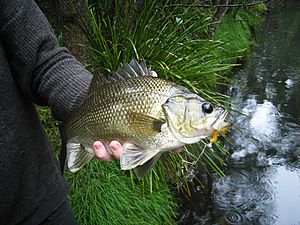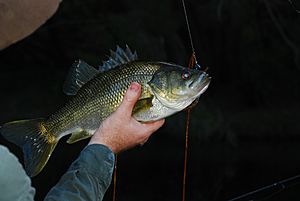Australian bass facts for kids
Quick facts for kids Australian bass |
|
|---|---|
 |
|
| Conservation status | |
| Scientific classification | |
| Synonyms | |
|
The Australian bass (Macquaria novemaculeata) is a cool fish found in rivers and streams. They live along the east coast of Australia. These fish are mostly found in fresh water. However, they must go to salty river mouths (estuaries) to lay their eggs.
Australian bass are part of the Percichthyidae family. They are important native fish in these river systems. People love to fish for them because they are strong predators. Until the 1960s, many people just called them "perch."
Contents
Australian Bass: A River Fish
The Australian bass is closely related to the estuary perch. Both fish look very similar. Estuary perch usually stay in the salty parts of rivers. They sometimes go into the very lowest freshwater areas. It is rare for these two species to breed together.
The scientific name for the Australian bass is Macquaria novemaculeata. The name novemaculeata is a bit of a mystery. It probably means "nine spines." This refers to the sharp, spiny fin on their back. This fin usually has nine spines.
What is an Australian Bass?
Australian bass have a body that is moderately deep. It is also long and flattened from side to side. They have a forked tail fin. Their other fins are angled. The spiny fin on their back is quite high and sharp.
They have a medium-sized mouth and big eyes. These eyes can look dark in low light. They might look red in bright light. The gill covers on Australian bass have very sharp spines. These can easily cut a fisherman's fingers.
The color of Australian bass can change. They might be metallic gold in clear, sandy streams. More often, they are bronze or bronze-green. This depends on the riverbed and water color.
Australian bass are generally a small to medium-sized fish. Wild river fish usually weigh about 0.4–0.5 kilograms. They are about 20–30 centimeters long. A fish weighing 1 kilogram or more is considered a good catch. The biggest river bass can be around 2.5 kilograms and 55 centimeters long in the south. In northern areas, they can reach 3.0 kilograms and 60–65 centimeters. Bass that live in dams often grow even bigger.
Where Do They Live?
Australian bass live in coastal rivers and streams. You can find them from Wilsons Promontory in Victoria. Their range extends north along the eastern coast. It goes all the way to the Bundaberg region in central Queensland.
They are not found in the Murray-Darling Basin. This river system is very large. However, it ends in lakes and lagoons. It also has only one shallow entrance to the ocean. These features do not suit the breeding habits of Australian bass.
Their Amazing Journey: Migration
Australian bass live mostly in freshwater rivers. But they must go to the salty river mouths (estuaries) to breed. Because of this, they move a lot. They live in the freshwater parts of rivers for most of the year. In winter, they move to the estuaries.
Here is how adult Australian bass usually move in central New South Wales:
- September: They return to the lower freshwater areas after laying eggs.
- October–November: They move through the middle freshwater parts.
- December–February: They go as far upstream as they can.
- March–April: They slowly move back downstream. This prepares them for their breeding journey.
- May: They make a strong run to the estuaries for breeding.
- June–July–August: They gather and lay eggs in the estuaries.
The exact timing of these movements changes. It depends on if they are in the north or south. It also depends on how much water is flowing in the river. Floods can help them pass over rapids.
Australian bass are found highest in rivers during summer. This is in December, January, and February. During this time, males and females live in different parts of the river. Males stay in the lower freshwater areas. Females travel far upstream into the middle and upper parts. They can travel very high up rivers. This is only limited by strong currents or dams. Historically, they could migrate up to 400–600 meters high in some rivers.
Home Sweet Home: Habitat
In the warmer months, Australian bass need good quality habitats. These are in the freshwater parts of rivers. They need healthy plants along the riverbanks. They also need places to hide in the water. Australian bass usually hide during the day.
They can use many types of hiding spots. These include sunken logs, undercut banks, and large rocks. They also hide under trees hanging over the water. Thick beds of water plants are also used. These hiding spots do not need to be in deep water. Bass are happy to hide in water as shallow as 1 meter.
Australian bass are strong swimmers. They can easily swim through rapids and fast water. However, they usually avoid sitting directly in strong currents. This helps them save energy.
At night, Australian bass swim near the surface. They actively hunt for food in shallow water. When they gather to breed in estuaries during winter, they hide less. They usually stay in deeper water.
What Do They Eat?
Australian bass are fierce predators. They eat many different things. Their common foods include:
- Insects that fall from land, especially cicadas.
- Small water creatures like caddisfly larvae.
- Crabs and shrimps from fresh water.
- Prawns from salty water.
- Small fish, like flathead gudgeon.
They will also eat any small creature that swims across their path. This includes mice, lizards, or frogs. Large Australian bass regularly catch these animals.
Growing Up: Life Cycle and Age
Australian bass grow very slowly. They can also live for a very long time. This is a common trait for large native fish in Southeast Australia. Living a long time helps them survive. It means most adults will get to breed during good years. These good breeding years often happen during wet 'La Niña' weather. These events might only happen every 10 or 20 years.
For many years, the oldest wild Australian bass found was 22 years old. But recently, a bass from the Genoa River was found to be 47 years old! Other bass were found to be 19 and 29 years old. This shows how long they can live.
How Australian Bass Reproduce
Male and female Australian bass are different sizes. Males usually grow to 1.0 kilogram or less. Females often grow larger than 1.0 kilogram. Some can reach 2.5–3.0 kilograms. Males are ready to breed at 3 years old. Females are ready at 5–6 years old.
Australian bass lay their eggs in estuaries during winter. This usually happens in July or August. Estuaries are places where fresh river water mixes with salty ocean water. The eggs are thought to sink to the bottom. Sea grass and other plants in the estuary likely help protect the eggs. The baby fish hatch in 2–3 days. Young Australian bass then move into freshwater rivers after a few months.
Even though they breed in estuaries, Australian bass need floods. Floods coming down the rivers in winter help them. They encourage adult bass to move and breed. Floods also help more baby bass survive and grow.
Adult and baby Australian bass might also go into the ocean during winter floods. This helps different river systems share their fish genes. This keeps the Australian bass populations healthy and similar. However, different rivers still have slightly different bass. This means it's important to use local bass for breeding projects.
Protecting Australian Bass
The number of wild Australian bass has dropped a lot since Europeans arrived.
Dams and weirs are a big problem. They block the fish from moving to estuaries to breed. They also stop them from reaching the upper parts of rivers. Most coastal rivers now have dams. If bass cannot reach the estuaries to breed, they will die out above the dam. Some dams block bass from most of their habitat. For example, Tallowa Dam on the Shoalhaven River used to be a bass stronghold. It blocked bass from over 80% of their old home. (But in 2010, a "fish lift" was added to the dam). Dams also stop the floods needed for bass to breed well. Other structures like poorly built road crossings also block their movement.
Another big problem is habitat damage. Sadly, land management practices in Australia have often been poor. Clearing plants along riverbanks hurts the habitat. Farm animals walking on riverbanks also cause damage. Lots of mud and dirt can wash into rivers. This makes them unlivable for Australian bass. The Bega River is an example. It lost most of its riverbank plants. Now, much of it is too muddy for bass and other native fish.
Australian bass grow slowly. This makes them easy to overfish. Too much fishing has caused their numbers to drop in the past. But things are getting better now. Most fishermen catch Australian bass and then release them. This is called catch and release.
Breeding Australian bass in hatcheries and releasing them helps. This creates fishing spots above dams. However, there are worries about this. It can affect the fish's genes. It can also accidentally introduce pest fish. Stocking can also hide the fact that habitats are still being damaged.
Fishing for Australian Bass
Fishing for Australian bass is popular in summer. This is when they are in the freshwater parts of rivers. Australian bass are amazing sportsfish. They are incredibly fast and powerful for their size. This is probably because they make long, tough journeys every year. When hooked, they swim straight for sunken logs or other hiding spots. Fishermen need strong gear to stop them.
During the day, bass usually stay near cover. Small lures and flies cast close to these hiding spots work well. Bass will strike at many types of lures. These include diving lures and soft plastic baits. Surface lures like poppers are also used. Fly fishing with flies that look like cicadas is very effective. At night, Australian bass swim around and feed near the surface. Surface lures that wiggle or fizz are used then.
Some of the best Australian bass fishing is in remote rivers. These places are hard to reach. Fishing there can be very rewarding. It's great for both the fishing and the beautiful scenery. Backpackers or kayakers often go to these remote bass spots. They are willing to drag their kayaks over obstacles.
Fishermen should remember that wild Australian bass move a lot. They can also be very wary in rivers. They are much more cautious than trout.
Almost all Australian bass fishermen practice catch and release. This is important to protect wild bass. Using barbless hooks is essential. You can make them by crushing the barbs flat with pliers. Bass hit lures very hard. It's almost impossible to unhook them with barbed hooks without hurting the fish. With barbless hooks, bass can be released quickly and easily.
Responsible fishermen now avoid fishing for wild Australian bass in estuaries during winter. This allows these important native fish to breed in peace. In 2014, the NSW Fisheries Department announced a closed season for Australian bass. This runs from May 1 to August 31.




